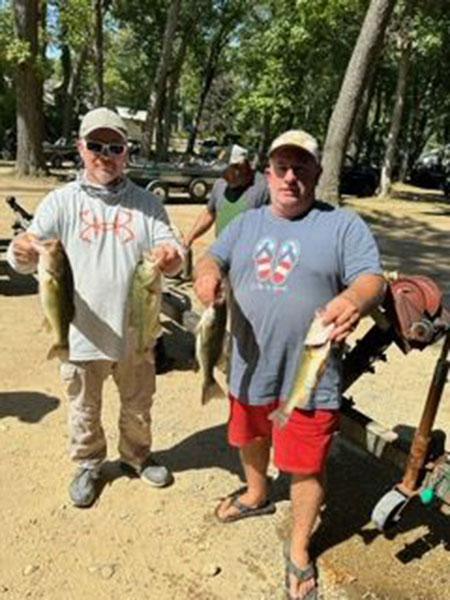- Details
Casting Couples Report
 Brent and Jake Burgess - 1st Place
Brent and Jake Burgess - 1st Place
Brent and Jake Burgess beat out eight other teams Sunday in the Casting Couples Open tourney at Magician Lake.
The Burgesses had five bass totaling 11.36 pounds to take home $240. Burgess used jigs in 5-12 feet of water.
 Rich Ozgood and Jake Horn - 2nd Place
Rich Ozgood and Jake Horn - 2nd Place
Rich Ozgood and Jake Horn were second ($120) with a 9.26-pound limit. They also fished jigs.
 Rick Kedik and Jake Lisenko - 3rd Place
Rick Kedik and Jake Lisenko - 3rd Place
Rick Kedik and Jake Lisenko finished third with five weighing 8.70 pounds. They also won the big bass pot ($40) with a 2.98-pound largemouth. They fished used jigs and topwaters to earn $40.
There were five limits caught for a total of 36 bass.
- Details
R&B Report
 Matt and Todd Hagerman - 1st Place
Matt and Todd Hagerman - 1st Place
Matt and Todd Hagerman won last weekend’s Palestine Lake tourney and captured big bass honors.
The Hagermans had 17.56 pounds that include a 5.48-pound giant. They caught their fish on poppers and jigs along weed edges.
 John Gipson and Adam Yeagley - 2nd Place
John Gipson and Adam Yeagley - 2nd Place
John Gipson and Adam Yeagley were second with 13.76 pounds caught in 4 to 8 feet of water on jigs.
Third place went to Dave and Matt (no last names provided) with 13.20 pounds. They fished jigs along breaklines.
Drew and Blake (no last names provided) had the second biggest bass with a 4.31-pound largemouth.
Any teams who fished at least 3 tournaments are qualified for the classic, which is Sunday, Sept. 29 on the St. Joe River in Benton Harbor from 8-4.
- Details
Four Flags Report

Jeff Stankovich and Paul Groves took home top honors in the Four Flags tournament at Austin Lake last weekend.
The winners ($220) had a limit weighing 13.17 pounds. They caught their fish on tubes in 1-3 feet of water.
 Dan Posey - 2nd Place
Dan Posey - 2nd Place
Dan Posey fished alone and had a limit weighing 10.85 pounds to pocket $132 for second. He caught his fish in 2-4 feet on TRD’s and jigs. He also had big bass with a 3.77-pound largemouth to earn a bonus $110.
 Mike and Ryan (no last names provided) - 3rd Place
Mike and Ryan (no last names provided) - 3rd Place
Third place went to Mike and Ryan (no last names provided) with five weighing 10.27 pounds. They said they caught their fish in 2-6 feet of water on jigs and Senkos. They won $88.
- Details
SMAC Report
Scott Crocker might finally stop complaining about Juno Lake.
 Scott Crocker - 1st Place
Scott Crocker - 1st Place
Crocker, who previously said he detests fishing Juno, went out Saturday in cold, windy conditions and put a butt-whipping on a handful of other teams fishing the Southwest Michigan Anglers Club season finale on the popular chain of lakes.
Crocker, who fished alone, had only of only two limits – and said he caught 15 keepers – taking home the first-place money and big bass pot. He had 12.19 pounds and a 3.30-pound largemouth. Crocker said he caught them on swim jigs, jerkbaits and bladed jigs in 4 to 10 feet of water.
 Kory Bloss and Kim Vaughn - 2nd Place
Kory Bloss and Kim Vaughn - 2nd Place
Kory Bloss and Kim Vaughn were second with five weighing 7.33 pounds. They fished Ned rigs and wacky worms around docks in shallow water.
 Pat Pilmore and Brent Burgess - 3rd Place
Pat Pilmore and Brent Burgess - 3rd Place
Pat Pilmore and Brent Burgess were third with four weighing 7.20 pounds. They fished jigs in 5 to 15 feet of water.
The next event is the Classic slated for Lake Leelanau Sept. 21-=22.
- Details
Tackle Shack report
 Roger Huffman and Troy Warstler - 1st Place
Roger Huffman and Troy Warstler - 1st Place
Roger Huffman and Troy Warstler went home $2,500 richer after winning the Tackle Shack Tournament on the Grand River last weekend.
Huffman and Warstler won with 15.79 pounds, worth $2,000, and had the biggest bass of the event, a 5.84-pound largemouth that earned them a bonus $500.
“Roger and I found a couple quality fish during our practice and that helped us key in on a shallow water crankbait bite,” says Warstler. “We had our limit within the first 90 minutes, including the 5.84 big bass and were able to make several culls throughout the day. Our last cull was near the end of the day and was a ½ pound upgrade.”
 Lee Duracz and Terry Burgess - 2nd Place
Lee Duracz and Terry Burgess - 2nd Place
Lee Duracz and Terry Burgess finished a close second with 15.74 pounds to win $1,400.
“We caught our fish early on a Super Spook Jr. over very shallow weeds, and then made some key upgrades cranking yachts with mid divers in the afternoon,” explains Duracz. “We had our limit in the boat by 8:06 a.m. We fished Strike King 3XDs and paralleled the giant boats around docks.”
 Bill Mathews and Kris Iodice - 3rd Place
Bill Mathews and Kris Iodice - 3rd Place
Bill Mathews and Kris Iodice locked down third place with 15.11 pounds. They won $900.
“We caught pretty much all of our fish on frogs and swim jigs in 2-4 feet of water,” says Mathews. “We had action pretty much all day with 1-2 of our good bites coming early, but we culled up later in the day. If we found bait, we found fish.”
 Jonathan Vanover and Jason Ridenovr - 4th Place
Jonathan Vanover and Jason Ridenovr - 4th Place
Fourth place money ($500) went to Jonathan Vanover and Jason Ridenovr who had 14.64 pounds. They fished 12 to 15 feet.
“We caught all of our fish on deep diving crankbaits. We had a couple key areas that produced all day,” offers Ridenovr.




